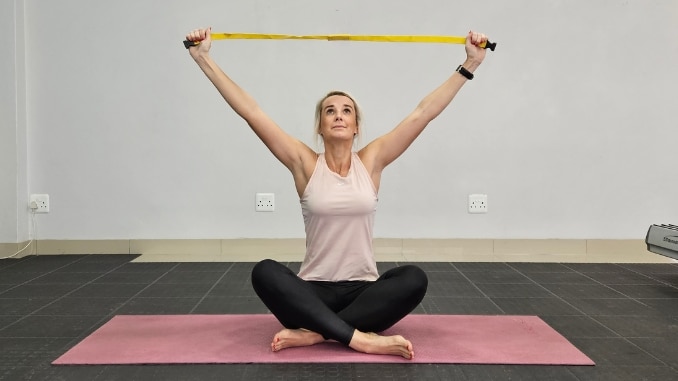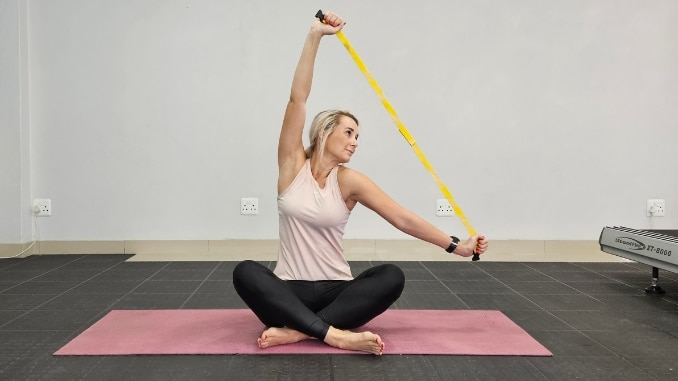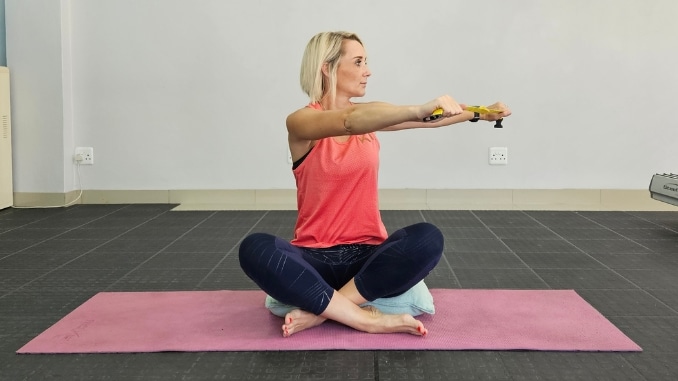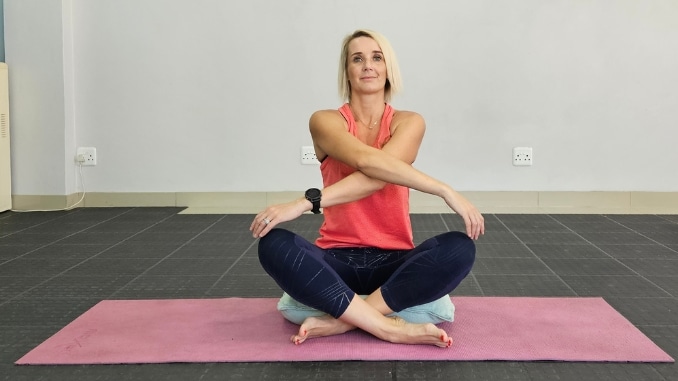Welcome to the world of flexibility and mindful with yoga strap stretches!
In a particular stage of our lives, we experience muscle pain and strain, especially exhausting our upper body to its limit. Specifically targeting areas susceptible to pain, tension, discomfort, and stress like the neck, shoulders, and back area. Thus negatively affecting our good body posture, and having an impact on our daily routine.
In this exploration of yoga strap poses, we delve into a realm of exercises designed to maintain proper alignment of body posture, enhance your flexibility, improve your range of motion, and deepen your yoga practice.
With their versatility and adjustable length, yoga straps become your trusted companions on this journey, allowing you to achieve optimal proper alignment and extend your stretches effectively. Whether you're a seasoned yogi, a yoga teacher, or a newcomer to the practice, join us as we unlock the potential of yoga strap stretches, promoting both physical well-being and a sense of tranquility through mindful movement.
What is a Yoga Strap?

A yoga strap is a versatile accessory designed to elevate one's yoga practice. This flexible band, equipped with loops, serves as a portable aid aimed at enhancing flexibility during yoga sessions. Using a yoga strap extends reach, enabling practitioners to delve deeper into poses. Furthermore, this supports securing limbs and providing stability, acting as an extra hand for an improved yoga experience. It also emerges as an indispensable tool for both seasoned yogis and newcomers looking to enrich their practice.
What is the Yoga Strap Used for?
Some common uses of a yoga strap include:
1. Deep Stretch
The yoga strap helps individuals stretch their muscles effectively, allowing for more controlled and deeper stretches. This is particularly beneficial for people practicing yoga, Pilates, or other activities requiring flexibility.
2. Rehabilitation
Physical therapists often use stretch-out yoga straps to assist patients with rehabilitation exercises. It can aid in improving range of motion and flexibility after injuries or surgeries.
3. Yoga Strap Stretches
In yoga practice, a yoga strap helps to extend the reach and help with various yoga poses, making them more accessible, especially for beginners.
4. Physical Fitness

A yoga strap can be used in fitness routines to target specific muscle groups and enhance overall flexibility and strength.
5. Injury Prevention
Regular stretching with a yoga strap can help reduce the risk of muscle injuries, cramps, and strains by improving muscle elasticity and range of motion.
6. Self-Massage
The loops on the yoga strap can be used to perform self-massage and release muscle tension by applying pressure to specific trigger points.
Why are Yoga Strap Stretches Important?
Using a yoga strap for upper body stretches offers numerous benefits that can enhance your yoga practice and overall well-being.
1. Increase Flexibility and Range of Motion
Deeper stretch exercises, facilitated by a yoga strap, enhance muscle and connective tissue length and suppleness. It helps you bend to tie your shoelaces or hinge forward to reach high shelves, easier and more comfortable.
2. Injury Prevention
Tight and inflexible muscles are more susceptible to strains, sprains, and other injuries. By regularly stretching with the use of a yoga strap, you reduce the risk of muscle and joint injuries. Stretches, accompanied by yoga straps, help maintain proper posture, reducing the risk of musculoskeletal issues.
3. Maintain Balance
Muscle imbalances can lead to joint instability and discomfort.
Stretching, facilitated with yoga straps, helps correct these imbalances by improving the flexibility of overactive muscles and strengthening underactive ones.
4. Muscle Relaxation and Tension Relief

Stretching with a yoga strap can relieve muscle tension and reduce soreness. It promotes increased blood circulation to the muscles, helping to flush out waste products and promote the delivery of essential nutrients.
This can aid in muscle recovery and relaxation, making you feel more comfortable.
5. Stress Reduction
Engaging in a stretching routine using a yoga strap often incorporates mindful breathing and relaxation techniques. This has the potential to alleviate stress and anxiety, fostering a sense of tranquility and mental wellness.
6. Posture and Pain Management
Stretching using a yoga strap can aid in correcting poor posture by addressing muscle imbalances. Over time, it can contribute to the alleviation of chronic discomfort, such as lower back pain, neck pain, or tension headaches.
7. Boost Energy and Vitality
Regular stretching using a yoga strap can invigorate your body and mind. It increases blood circulation, supplying more oxygen and nutrients to your muscles and organs. As a result, you may feel more energized and vital, ready to take on the day with enthusiasm. It’s time to explore the transformative power of yoga poses using yoga straps in the comfort of your home.
Best Yoga Strap Stretches for Relief
Warm-Up
Breaths
For this warm-up exercise, use a cushion to support your pelvis in a forward position.
Begin in an upright sitting position on the floor with your legs crossed in front of your body, maintaining good alignment with your head, shoulders, and hips. Place your hands on your knees. Engage your core, then close your eyes and take several deep belly breaths, in through your nose and out through your mouth.

Routines
1. Seated Side Stretch
For this exercise, utilize a yoga strap, belt, or a dog's leash.
Begin in an upright sitting position on the cushion with your legs crossed in front of your body, maintaining proper alignment with your head, shoulders, and hips. Grip the middle of the yoga strap in both hands, placing it in front of your body with your arms shoulder-width apart at chest height. Engage your core and slowly bring your shoulders to one side, holding this position for a few seconds. Return to the starting position and repeat the movement on the other side.
To make the exercise more challenging, counter the movement by tilting your head to the opposite side. Complete 1 set of 8 repetitions on each side.
 |
 |
2. Upper Back Stretch
For this exercise, utilize a yoga strap, belt, or a dog's leash.
Begin in an upright sitting position on the cushion with your legs crossed in front of your body, maintaining proper alignment with your head, shoulders, and hips. Hold the middle of the yoga strap with both hands, extending your arms in front of your body at shoulder height. Engage your core. Looking for a stretch on your upper back and shoulder blade area, round your shoulders as you push the strap away from your body. Relax and return to the starting position. Repeat the movement as needed.
 |
 |
3. Seated Overhead Press
For this exercise, utilize a yoga strap, belt, or a dog's leash.
Begin in an upright sitting position on the cushion with your legs crossed in front of your body, maintaining good alignment with your head, shoulders, and hips. Hold the middle of the yoga strap with both hands, extending your arms in front of your body at shoulder height. Engage your core. Pull the strap apart to create resistance, then press your hands overhead. Hold this position for several deep belly breaths. Return to the starting position, maintaining tension on the strap. Repeat the movement as needed.
Start off with 1 set for 5 repetitions.
 |
 |
4. Cow Face Arms
For this exercise, utilize a yoga strap, belt, or a dog's leash.
Begin in an upright sitting position on the cushion with your legs crossed in front of your body, maintaining good alignment with your head, shoulders, and hips. Hold one end of the yoga strap in one hand, raise your arm overhead, and bend your elbow to lower the yoga strap behind your back. Use your other hand to grab the lower end of the yoga strap behind your back. Use your upper hand to gently pull the yoga strap upward until you feel resistance on your bottom arm. Hold this position for several deep belly breaths, in through your nose and out through your mouth. Relax and repeat the movement on the opposite side.

5. Seated Chest Stretch
For this exercise, utilize a yoga strap, belt, or a dog's leash.
Begin in an upright sitting position on the floor with your legs crossed in front of your body, maintaining good alignment with your head, shoulders, and hips. Position your arms behind your back, holding the middle of the yoga strap in both hands. Pull the strap apart by opening your arms out at your sides. Engage your core. Looking for a light stretch at your back, lift your hands away from your body, slightly arching your mid back. Hold this position for several deep belly breaths, in through your nose and out through your mouth. Relax and repeat the movement as needed.

6. Wide Arm Lifts Backwards
For this exercise, utilize a yoga strap, belt, or a dog's leash.
Begin in an upright sitting position on the floor with your legs crossed in front of your body, maintaining good alignment with your head, shoulders, and hips. Hold the ends of the yoga strap in both hands, then open your arms out to the sides at chest height, creating tension on the yoga strap. Engage your core. Inhale and bring your arms overhead. Exhale and slowly roll your arms behind you, maintaining tension on the yoga strap. Reverse the sequence of movements to return to the starting position.
To make the exercise more challenging, you may gradually lower your stretch by rolling your arms behind you. Complete the movement for 5 repetitions.
 |
 |
 |
7. Wide Arm Side Bend
For this exercise, utilize a yoga strap, belt, or a dog's leash.
Begin in an upright sitting position on the floor with your legs crossed in front of your body, maintaining good alignment with your head, shoulders, and hips. Hold the ends of the yoga strap in both hands overhead with your arms wide apart, creating resistance on the strap. Engage your core and bend your upper body to the side, maintaining tension on the yoga strap. Hold this position for a few seconds with several deep belly breaths; in through your nose and out through your mouth. Return to the starting position and repeat the movement on the opposite side.
Complete for 8 repetitions.
 |
 |
8. Twist
For this exercise, utilize a yoga strap, belt, or a dog's leash.
Begin in an upright sitting position on the cushion with your legs crossed in front of your body, maintaining good alignment with your head, shoulders, and hips. Hold the middle of the yoga strap in both hands with your arms extended out to the sides, ideally at chest height. Engage your core and twist your upper body to one side, holding this position for a few seconds. Return to the starting position and repeat the movement on the opposite side.
Complete for 6 repetitions.
 |
 |
Cool Down
Dynamic Movements
Begin in an upright sitting position on the cushion with your legs crossed in front of your body, maintaining good alignment with your head, shoulders, and hips. Cross your arms in front of your body by resting your hands on the opposite knees. Engage your core and swing your arms out at your sides, extending your arms back to open your chest. Return to the starting position and repeat the movement as needed.
 |
 |
Begin in an upright sitting position on the cushion with your legs crossed in front of your body, maintaining good alignment with your head, shoulders, and hips. Engage your core and twist your upper body to the side, swinging both arms in the same direction. Return to the starting position and repeat the movement on the opposite side.

Additional Routines For Flexibility and Pain Relief
- Boat Pose
- Triangle Pose
- Big Toe Pose
- Seated Forward fold
- Pigeon Pose
1. Boat Pose
Begin in an upright sitting position on the floor with your knees bent and your feet flat, maintaining good alignment with your head, shoulders, and hips. Tighten your abdominal muscles and lean your upper body back. Straighten your arms at your sides and extend your legs up toward the ceiling. Hold this position for several deep belly breaths, in through your nose and out through your mouth. Relax and return to the starting position. Repeat the movement as needed.
This Boat Pose strengthens the core and improves balance.
2. Triangle Pose
Begin in an upright standing position with your feet considerably wider than shoulder-width apart, maintaining good alignment in your upper body. Bend one knee and pivot your foot so that your toes are pointing out to the side, ideally at a 45-degree angle. Contract your core and bend your upper body sideways over your bent knee. Reach one arm towards the ceiling as you lower your other arm towards the floor. Take a couple of deep belly breaths, in through your nose and out through your mouth. Return to the starting position and repeat the movement on the opposite side
3. Big Toe Pose
Begin in an upright standing position with your feet hip-width apart. Engage your core and hinge through your hips to bend your upper body forward, keeping your spine long and straight. Reach down and hold onto your big toes with your thumb, index, and middle fingers. Inhale and lengthen your upper body, then exhale and fold deeper into the pose, bringing your chest closer to your thighs. Hold this position for a few deep belly breaths, in through your nose and out through your mouth. Relax and return to the starting position.
This standing forward bend not only stretches tight hamstrings and calves but also engages and strengthens the upper body's muscles.
4. Seated Forward Fold
Begin in an upright sitting position on the floor, maintaining good alignment with your head, shoulders, and hips. Extend both legs in front of your body with your feet close together and your toes pointing upward. Contract your core, then hinge through your hips to bend your upper body forward, reaching your toes with both hands. Hold this position for several deep belly breaths, in through your nose and out through your mouth. Relax and return to the starting position.
6. Pigeon Pose
Move into a straight-arm plank position, maintaining good alignment with your head, shoulders, hips, and legs. Lift your right knee towards your shoulder, cross your foot under your opposite hip, and lower your knee to the side. Lower your upper body onto your bent leg and rest your forehead on the floor while keeping your left leg back. Hold this position for several deep belly breaths, in through your nose and out through your mouth. Return to the starting position and repeat the movement on the opposite side.
Conclusion
Our bodies have their limits, just like everything else. As a result, we often experience back pain, tight shoulders, and neck tension. It is essential to address these issues through a proper workout, whether standing or seated, as a proactive step in your journey toward a healthier lifestyle.
Yoga props are often used to help individuals conquer different poses that might require flexibility or balance that they have not yet mastered. Check out this Yoga Props 101 now!





